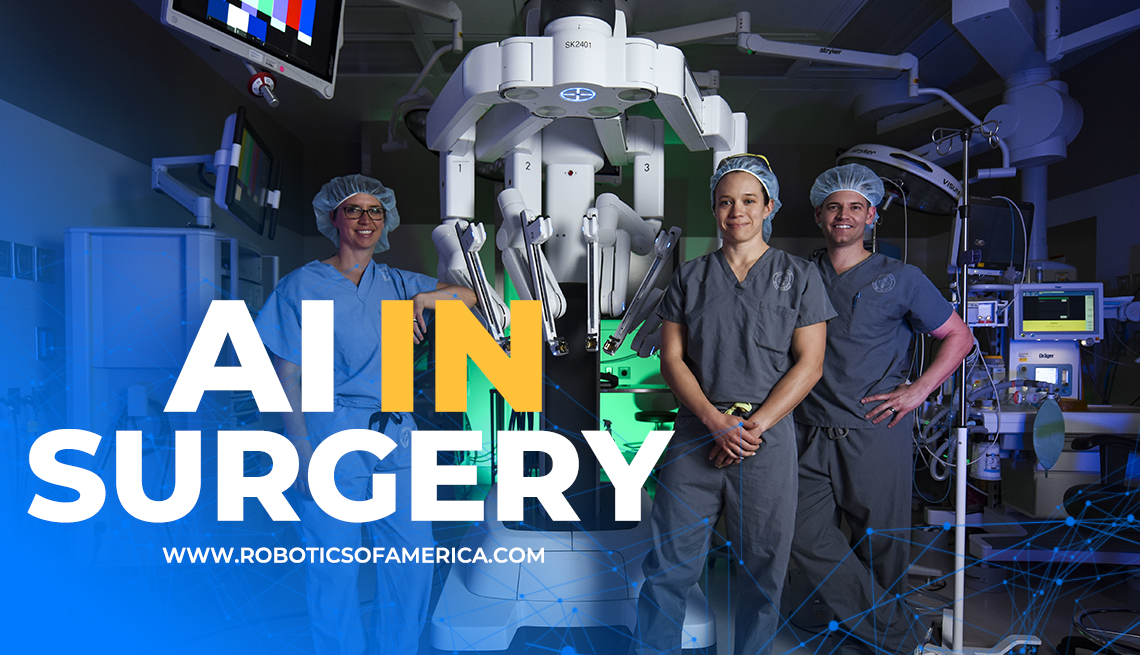
An Introduction to AI in Surgery
AI in surgery is no longer a fantasy. It is a reality that is contributing to the health and safety of patients worldwide. Best of all, developments in medical AI are continuing to occur on a daily basis. The mission of AI researches is to improve both a doctor’s capabilities and his or her patient’s well-being.
Sure, the involvement of AI in surgery concerns some health professionals. There is the potential for a patient’s data privacy to get violated. There is potential for machines to make critical errors. But what is the biggest potential factor when it comes to AI in surgery?
It is that technology will allow humans to live longer. And that is a major advantage that cannot get ignored. That is why this article will examine current surgery-related examples that involve AI. Are you ready? Let’s get started.
To Understand AI in Surgery, We Must First Understand AI Itself
Before we get into AI in surgery, let’s examine what AI is. AI stands for artificial intelligence. Artificial intelligence involves using algorithms to provide machines with human-like qualities. For example, once a machine has AI, it can gain many abilities such as these:
- -having the ability to reason
- -having the ability to use logic
- -having the ability to solve problems
- -having the ability to interpret words
- -having the ability to interpret physical objects
- -having the ability to make independent decisions
- -performing other basic cognitive functions
You might have assumed that AI only exists in science fiction books and movies. But it is here in the real world. And it is here to stay. The following section focuses on how AI is impacting surgeries across the world. You might get surprised at how advanced artificial intelligence has become.
Current Real-World Examples of AI in Surgery
1) Robotic AI in surgery.
Yes, more and more robots are contributing to the concept of AI in surgery. In fact, it is not a concept any longer. It is a reality. Healthcare robots have an estimated worth of over forty billion dollars. What makes these AI-powered machines worth so much cash? Their abilities.
Surgery robots can process data by looking at pre-op medical records. The information gets used to guide the surgeon’s tools throughout each surgery. What is the end-result of these AI robots assisting surgeons? Studies have shown that there is a 20% reduction in how long patients must stay at medical facilities. The majority of AI robot-assisted surgeries have minimal invasive levels.
This means that patients will not have to spend much time healing from their huge incisions. Thanks to AI, robots are able to remember what they learn during each of their surgeries. They then apply that knowledge, such as new techniques, to their future surgeries. This AI-powered process improves the quality of each surgeon’s operations over time.
There was a recent study that examined many orthopedic patients. Some of the patients had normal surgeries and some had AI robot-assisted surgeries. What was the conclusion of the study? The patients not in AI robot-assisted surgeries did not benefit at all. How so? They had five times more medical complications than the patients assisted by robots.
You might be asking the following question right now. What type of surgery can an AI robot benefit? Every single kind. Have you heard of the Da Vinci robot? It has gained worldwide recognition for assisting doctors during eye surgeries. It can perform difficult maneuvers with more precision than humans are capable of. This concept also applies to Heartlander.
The Heartlander is a miniature robot that assists heart surgeons. This AI-powered robot can create small incisions on each patient’s chest. It then performs advanced maneuvers to do mapping across every heart’s surface. Hey, who said robots were heartless? (Sorry for the lame joke.)
2) Virtual nursing assistant AI in surgery.
Not all AI in surgery has to do with machines that do actual surgical procedures. But virtual nursing assistants are also important. They can interact with each patient on a one-on-one basis. In other words, they help patients get taken care of in a variety of ways. Analysts project AI assistants will save the medical sector $20 billion per year. Why? They offer 24/7 care to patients at all times. Here are some more key advantages of AI virtual nursing assistants:
- -they are available around the clock to assist patients
- -they can answer most questions that patients have
- -their answers can get delivered within seconds of each question
- -they focus on each patient at all times as part of routine monitoring
Think of AI virtual nursing assistants as a bridge. They are connecting patients to their care providers at all times. Improved communication boosts the patients’ entire experiences. It also reduces the number of unnecessary hospital visits and readmissions. The modern virtual nursing assistant can also conduct routine wellness checks. These health checks are possible thanks to both AI and voice software.
3) Diagnosis-capable AI in surgery facilities.
Modern AI in many surgery facilities has the ability to diagnose many patients. But do not get mistaken. AI diagnosis processes and capabilities are still somewhat limited. But successful cases are becoming more common by the year. For example, a recent Stanford University study focused on medical AI algorithms. Researchers wanted to know if algorithms were strong enough to detect skin cancer. What was the result? The AI detected skin cancer, as well as any human dermatologist, can. But that’s not the only test involving diagnosis-capable AI.
A software business tested AI that assists dispatchers during emergency calls. The AI would use its algorithm to analyze what every caller had to say. The AI could interpret factors like the tone of each voice and background noises. What was the result? The AI detected cardiac arrests 20% better (and faster) than human dispatchers could.
Imagine how findings like these will lead to benefits for surgeons. Patents will not only get treated faster. The staff will have a better understanding of key survival practices for patients. Say a patient fears that he or she has cancer growing in their body. The AI will be able to diagnose that cancer faster than humans ever could. This will shorten the time leading up to surgeries. What is the end result? Many people’s lives will get saved. And it’s all thanks to AI that’s smart enough to diagnose patients.
4) Workflow AI in surgery facilities.
AI in surgery and healthcare facilities is boosting many administrative tasks. With robots and machines taking care of workflow, there are going to be huge savings. In fact, the medical industry's projected to save almost $20 billion dollars. The savings will take place once workflow AI bots become commonplace. Surgeons will have more time in their days to concentrate on other important tasks.
Let’s use voice to text transcriptions as an example of the power of AI. Algorithms will help machines conduct the transcriptions without the need for human staff. Machines will be able to prescribe medicine, write chart notes, and order testing. Does this scenario sound like it’s many years away from reality? It’s not. Below is a current example.
The Cleveland Clinic has a partnership with IBM. Doctors there are using IBM’s Watson computer to sift through large amounts of data. The computer uses that data to relay information to doctors. This leads to faster treatment for patients. Imagine going through thousands of medical documents in mere seconds. This is possible thanks to developments in AI. Expect machines like Watson to appear in many surgery centers in the coming years.
5) Image analysis AI in surgery facilities.
AI in surgery is going to revolutionize the image analysis process. As you may know, standard image analysis procedures often take quite a bit of time. That’s why an MIT research unit created a machine-learning algorithm. The algorithm analyzes 3D scans fast. How fast? The scans are…get this…1,000 times faster than standard image analysis scans.
How will these fast real-time scans benefit surgeons? The surgeons will have access to important data in a matter of seconds. Not to mention, AI developments are going to have a huge impact on radiology. Algorithms will improve any medical tool that does not focus on tissue samples.
AI will allow more patients to begin the surgery process at home. They will use their smartphones to take pictures of ailments. Then the image analysis AI at a surgery center will process the pictures. This will help surgeons figure out what route to take faster than ever before.
Conclusion: AI in Surgery is Helping to Save Lives
There is no limit to the benefits that having AI in surgery will provide patients in the future. And it is already making a big difference. Advanced tools are shortening waiting times. They are analyzing data fast. And they are helping surgeons do their jobs better. There’s no doubt about it. Machine learning inside surgery centers is here to stay. And that’s a good thing.
Better quality surgeries are going to be the ultimate result of using advanced AI. Do you want to learn more about the use of AI in surgery? If so, please come back to our website soon. We will have more articles based on the following related subjects:
- -AI in surgery companies
- -Artificial intelligence in surgery PDF
- -AI in healthcare
- -robotic surgery
- -surgical robots
- -artificial intelligence in surgery: promises and perils
- -artificial intelligence and the future of surgical robots
- -AI in brain surgery

